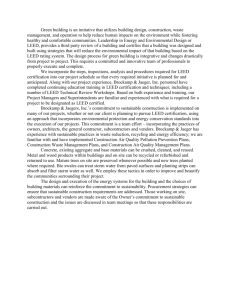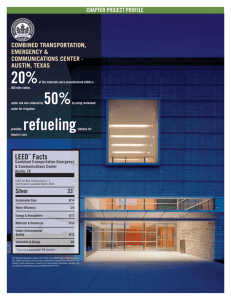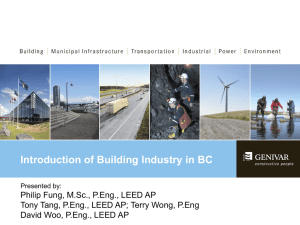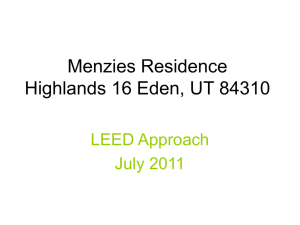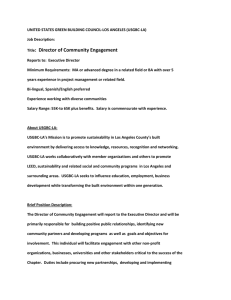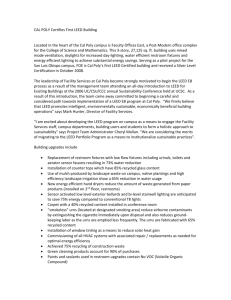Beyond LEED, Sustainable Laboratory Design
advertisement
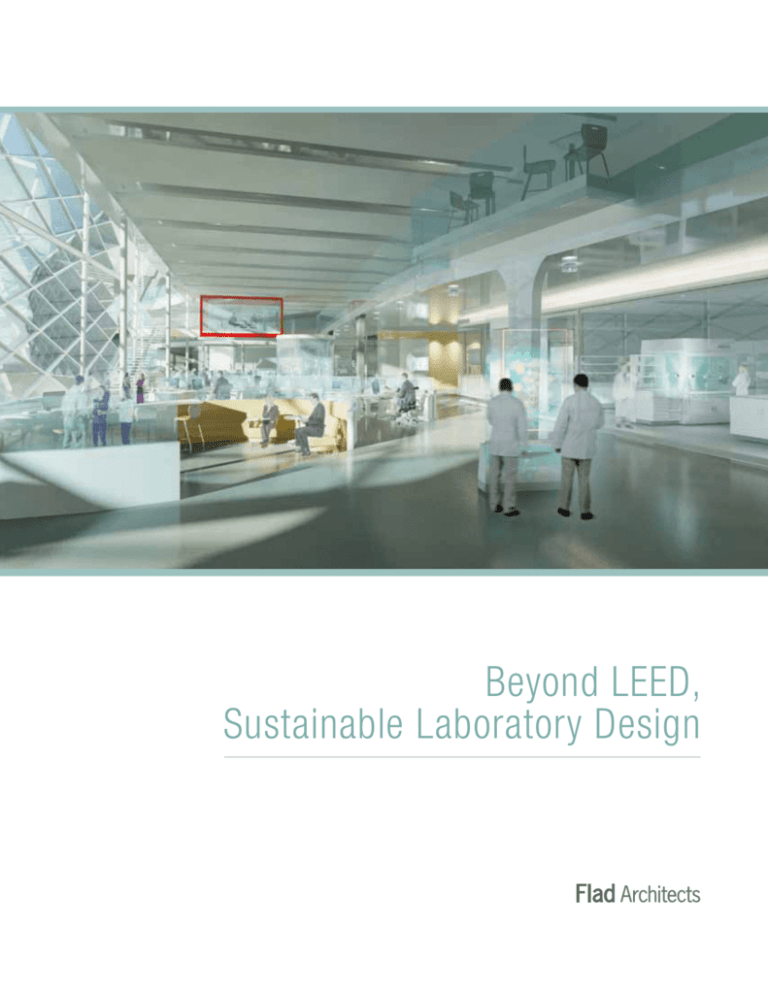
Beyond LEED, Sustainable Laboratory Design Beyond LEED, Sustainable Laboratory Design The U.S. Green Building Council’s LEED® (Leadership in Energy building practices, we identified that the goal of the program and Environmental Design ) Green Building Rating System™ is not to completely mitigate a facility’s environmental impact. has furthered the pursuit of sustainability, generating increased To actually create a sustainable facility, it must, in fact, fully efforts by both owners and the construction industry to develop sustain itself. Therefore, a sustainable facility, by definition, new ways of reducing the environmental footprint of a variety must meet the following criteria: of facilities, including laboratories. However, to move beyond the goal of merely reducing that footprint, and choosing to eliminate a facility’s environmental impact altogether, requires the incorporation of new technologies, the exploration of new design approaches, and the modification of user behaviors. Net-Zero Energy Use Net-Zero Water Use Net-Zero Carbon Footprint Zero Waste During Construction & Operation If we assume these combined goals are possible, there are In recent years, Flad Architects has been asked to address a multitude of questions to be addressed. What solutions unusual situations faced by our clients while creating facilities can compensate for the high energy loads and ventilation of to meet higher levels of sustainable design criteria. Incremental laboratories? What would it take to produce all the needed solutions were not enough to fully address these challenges, energy on site, as well as enough energy to sell back to the requiring the design team to develop uncommon strategies grid to result in a net-zero balance? If it is actually possible to redefine what a truly sustainable laboratory would be. to achieve these goals with the technologies available today, Through a series of discussions, we clarified our own beliefs would it be financially feasible? about sustainability and LEED’s use as a tool to reduce a During our search for the answers to these questions, it facility’s environmental impact. However effective the LEED became apparent that these endeavors also required a more program is at moving the market toward more sustainable holistic response from the operators and designers of the Beyond LEED, Sustainable Laboratory Design 1 laboratories, while remaining engaged in the fiscal realities and striving to be an exemplary model of environmental of the projects. The entire project team must increase its responsibility. In addition to the challenges found in any focus on finding innovative ways to do more, while reducing research facility, we had to address the challenges posed by energy use and minimizing waste. Each tactical investment the tropical, equatorial zone. As energy usage is greater in must demonstrate an equivalent return by reducing energy this hot and humid climate, the REL faced increased energy consumption or the environmental impact on the site. costs. Challenges also included preparing a laboratory for This paper addresses those challenges and the new frontiers available once a project sets goals beyond LEED Platinum. Two projects embodying these challenges were a confidential client’s Renewable Energy Laboratory (REL) in Kuala Lumpur, Malaysia, and Stony Brook University’s Advanced Energy Research and Technology Center (AERTC) in New York. sustainable operations in a developing country. Our primary strategy to address these challenges was to generate as much on-site renewable energy as possible to off-set the facility’s consumption. Stony Brook University’s goal for the AERTC was to create an energy research complex that reached beyond the goal of LEED Platinum. The primary challenge posed by this project The REL is intended to lead the world in the research of was that the facility was to be located on a site without a biomass conversion, as well as the development of other municipal sewer system, forcing the design team to implement renewable energy sources available near the equator. strategies to minimize chemical lab waste and to develop The facility needed to reflect the client’s commitment to systems for dealing with that waste on-site. sustainability by moving beyond the confines of LEED When faced with projects such as these two examples, the design team must move beyond a standard approach, addressing the challenges with high performance design, safety philosophies, and behavioral changes; seeking strategies with compounding effects. High Performance Design To achieve the most energy efficient facility, the design team must ensure architectural and mechanical systems are fully integrated – working in tandem, to achieve more than either system could achieve functioning independently. This partnership between systems results from several factors, including an integrated design plan incorporating passive design strategies, daylight integration, and expert lab and office planning, among others. Beyond LEED, Sustainable Laboratory Design 2 Integrated Design Plan Passive Design The first step to fulfilling a strong sustainable agenda is By optimizing the use of natural environmental climate incorporating that agenda into the Integrated Design Plan (IDP). factors, passive design can significantly reduce the facility’s Rather than simply taking the established business objectives and dependence on active mechanical systems. High quality moving forward with the design, this process engages all parties passive design includes identifying and incorporating heating, involved with the project in a visioning session at the outset, cooling, and ventilation opportunities that are specific to the to establish the benchmarks, metrics, and standards toward building’s climate, location, and program. which the project will aim. By involving the client leadership, project management, design team, and both the facility users and operators at the beginning of the process, everyone is fully informed of the business objectives, design strategies, and desired outcome involved with the project and can participate in shaping the necessary tactics to pursue those objectives. In the case of REL, providing shade for the building was of paramount concern, due to the equatorial location, so our plan incorporated a two-tiered approach. First, a solar shading canopy was created at the roof level to shade both indoor and outdoor spaces. The canopy was created through the incorporation of a large photovoltaic array to not only shade the This process is carried through the duration of the project, area but capture sunlight and transform it into energy used to affording the opportunity for the building’s performance cool the building and provide power. Second, we integrated strategy to evolve and adapt to usage demands throughout a green roof into the facility to provide additional insulation, the expected life of the building. Using this process to unify prevent a heat island effect, and reduce storm water run-off. the vision and form consensus lays the groundwork for the success of the entire project. To achieve the greatest impact, each design strategy used multiple tactics to address environmental issues. This Beyond LEED, Sustainable Laboratory Design 3 multidimensional approach, with different systems performing dual and triple duty, allowed for solutions that were easy to maintain and had no mechanical dependence. Daylighting Establishing a balance between luminance and illumination involves calculated environmental analysis. By reducing the building’s dependency on artificial light, we can effectively reduce the building’s energy loads, creating opportunities for interior daylight, as well as creating views of the outdoors which contribute to the occupants well being and productivity. Lab & Office Planning The design team must perform an analysis of the real In the case of the AERTC and other northern hemisphere sites, occupancy patterns of the building to ensure enough light is architectural planning concepts can also contribute toward available when needed, and also to ensure areas are not over additional energy savings. For example, by placing high lit when they are not occupied. This analysis must include the ventilation labs on the south side of the facility, laboratory air use of sophisticated technology to measure, understand, and change rates will already be addressing solar heat gain loads predict the way light will be utilized within the space for both imposed on the south elevation. Additionally, in the winter, high function and quality. sensible load labs facing north can contribute toward heating This modeling can often lead to changes in the form and orientation of the building to make natural light available throughout the facility, ensuring a healthier and more productive work space. a space, further reducing demands on the building for heating loads. By locating some conference functions either within or adjacent to labs, it may be possible to reduce the overall volume of laboratory zoning while maintaining the flexibility of the lab space. During this process, it is important to seek different heating and cooling strategies for office spaces, as offices need fewer air changes than labs. It is also important to seek opportunities to condition these and other non-ventilation demanding spaces using water instead of air, as it requires less energy to move water through the facility. As offices have a different definition of flexibility, we can consider utilizing more hydronic conditioning, as well as considering displacement heating and natural ventilation. Beyond LEED, Sustainable Laboratory Design 4 through the use of occupancy sensors and automatic sash shut-offs. Another tactic for energy savings is reducing the capacity of the system by accurately diversifying lab occupation and fume hood operations. Not only can this reduce energy use, it can reduce the owner’s initial investment. Although building owners often ask to have the air handling system accommodate 80 to 95 percent hood usage, studies have shown that laboratory air handling systems are consistently over designed, well beyond the needed capacity. In the majority of labs, 75 to 85 percent of fume hoods are not Safety Philosophies being used at any given time, but are operating and using a Moving beyond design consideration, there are great significant amount of energy. opportunities available through reevaluating an organization’s safety protocols and procedures by introducing energy concerns into the decision matrix. A balance must be achieved between user safety and energy use. Instead of addressing safety issues with a one-size-fits-all approach, a calculated management of safety issues must be developed based on the intricacies of the specific facility and guided by an agreed-upon The only way to calculate the safe and appropriate air flow rate is through the use of computational fluid dynamic modeling. With computer models, we can understand the performance requirements of the space, while designing a laboratory that minimizes energy use and maintains a healthy environment for the staff. safety philosophy. Ventilation & Air Conditioning Ventilation and air conditioning are the dominant energy consumers in a lab and their requirements are primarily driven by safety concerns. The two most promising strategies to reduce energy use are the proper control of air changes in the lab and new fume hood designs. By designing demand-driven systems and enabling users to turn off equipment, a large amount of the energy used in the laboratory can be eliminated. This can be accomplished Beyond LEED, Sustainable Laboratory Design 5 A ductless fume hood acts much like a biosafety cabinet in User Adaptation that it filters the air before circulating it back into the room Beyond design and planned safety processes, the greatest environment. When we can safely incorporate this energy challenge faced by any facility is modifying the behaviors of efficient device into the lab, we could reduce conditioning loads the people who use it on a day-to-day basis. Making people by orders of magnitude through minimizing the exhaust rate. aware of the processes and procedures to get the most out There are many obstacles remaining before use of the new of the facility is only the first step in changing their behavior fume hoods will be widely accepted. Filters must be changed over the long term. Systems must be in place to measure and regularly and certain volatile, small molecule compounds track energy utilization patterns and their impact on the facility, cannot be filtered by these hoods. Only a motivated user team correcting inefficient behaviors and giving users incentives will make the effort to change their procedures to maintain the to improve. The systems must be designed to react to the equipment and effectively manage its use. user’s demands. Individual staff can be extremely motivated to improve their resource consumption and should be rewarded Behavioral Changes for careful behavior by returning savings to the team for other True changes to our environmental footprint will require expenses. Over the life of the building, the users themselves behavioral changes in the way we use laboratories and will need to track the energy use of the facility to identify resources. Operation and user behavior will have the largest opportunities to increase its efficiency as techniques and effects on resource use over the lifespan of the facility. technologies improve. Beyond LEED, Sustainable Laboratory Design 6 Integrating the lab utilization demands in the design process goals of the users while analyzing the laboratory operations allows a designer to uncover potential improvements in many to locate every opportunity for cost and energy savings. ways. For example, containment of lab waste and water Each strategy requires planning, forward thinking, constant conservation are possible today to a degree that water waste modeling, measuring, and management as the project unfolds. can be minimized to almost zero. While many might find this By moving beyond common strategies, incorporating high an impediment in their working productivity it also creates performance design, thoroughly integrating a safety philosophy, opportunities to provide more flexible laboratory layouts. and modifying the behavior of the users, a design team can Movable sinks that are serviced from above are possible and again relieve us from a fixed type of infrastructure that is costly to maintain and modify. create a facility that moves beyond LEED metrics and is truly sustainable. Conclusion To achieve an actual sustainable laboratory, we must take a holistic view of the project. Lab design must be approached from a broad perspective, maintaining the vision and business Energy Consumption (kBtu per ft 2) Achieving Net Zero Energy Use Common Strategies High Performance Design Safety Philosophy Behavioral Changes 0 Energy Reduction Strategies Beyond LEED, Sustainable Laboratory Design 7 Flad Architects has earned a reputation for outstanding client service, fiscal responsibility, and design excellence over its 80-year history. Specializing in the planning and design of innovative science facilities for academic, healthcare, government, and corporate science and technology clients, Flad is nationally known and honored for its planning and design expertise. In addition to traditional architectural services, Flad provides strategic facility planning and programming, laboratory planning, interior design, landscape architecture, and structural engineering. Madison: 644 Science Drive, Madison WI, 53711, 608-238-2661 n Flad Offices I Atlanta, GA Gainesville, FL Madison, WI Raleigh, NC San Francisco, CA Stamford, CT Tampa, FL www.flad.com © 2010 Flad Architects

